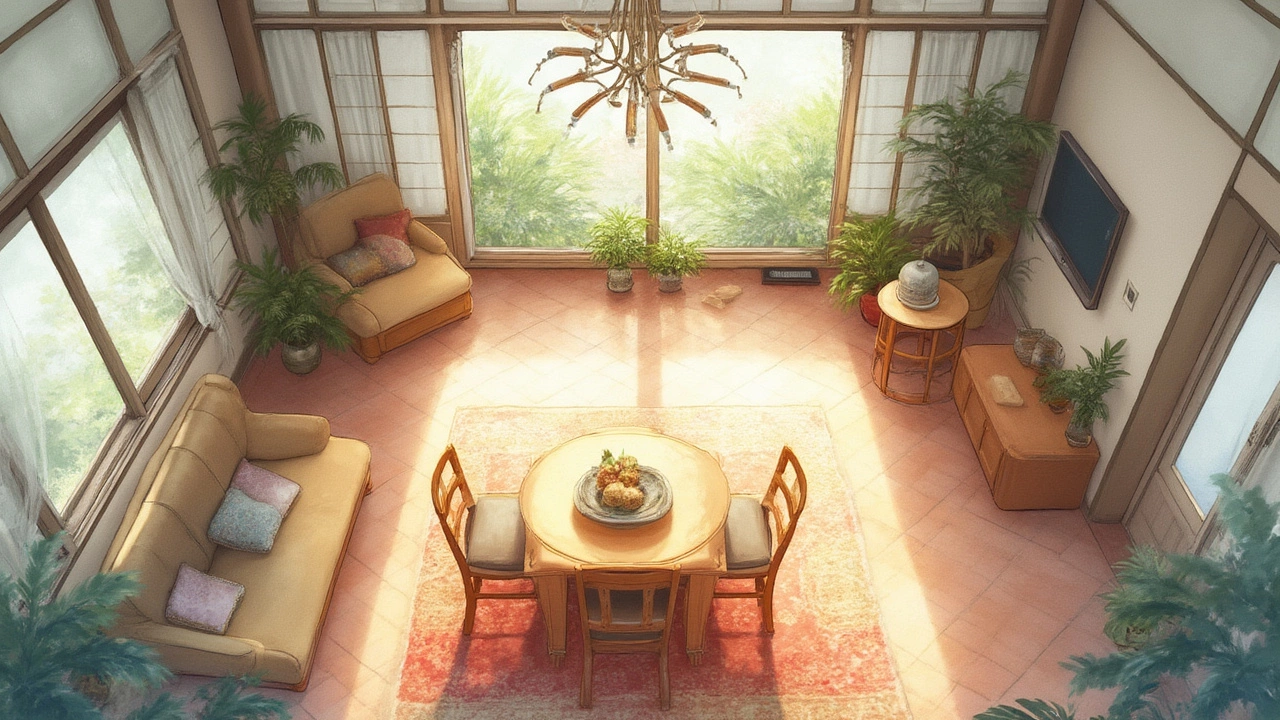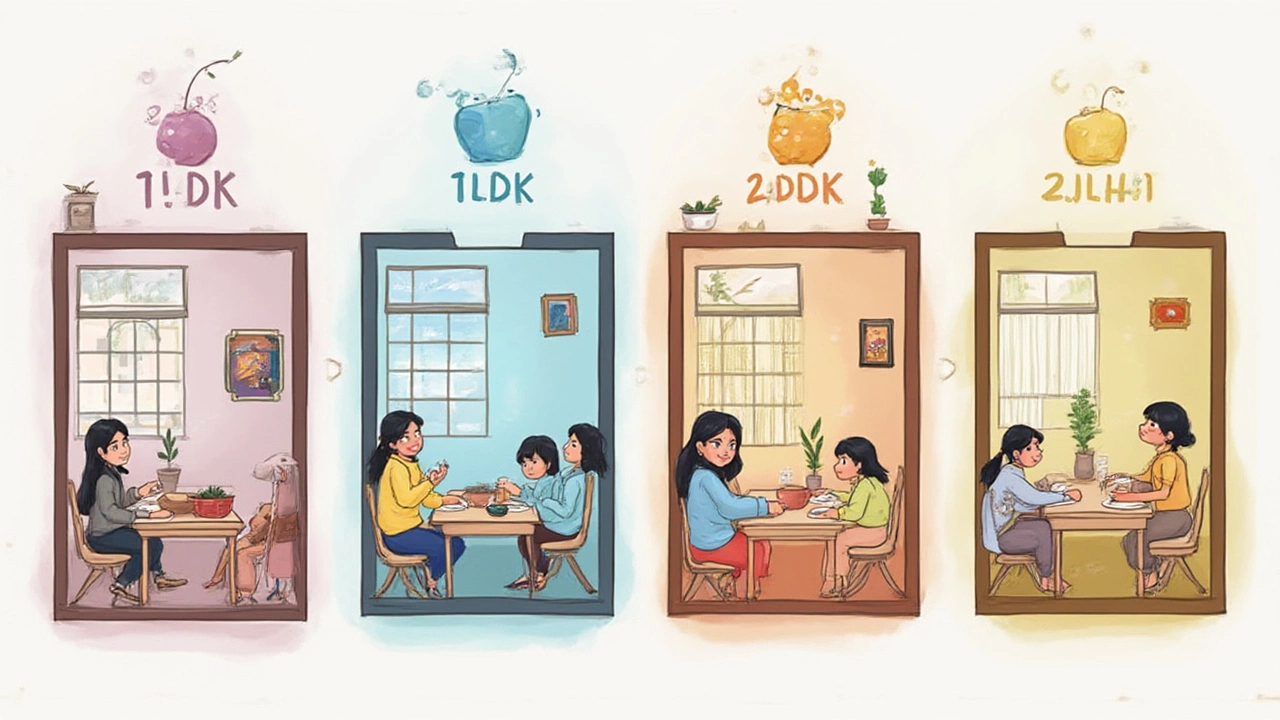2DK Apartment Explained: Japanese Apartment Layouts, Features & Renting Tips

Jul, 20 2025
If you’ve ever browsed Japanese rental listings, you’ve probably come across strange codes like “2DK” or “1LDK.” At first, they look like robot serial numbers. But these codes actually tell you a ton about the apartment’s layout and whether it fits your lifestyle. A 2DK apartment, in particular, hits a sweet spot for plenty of renters—singles, couples, even tiny families. But what exactly does this odd little code mean? And why are 2DKs so common, especially in Japanese cities?
Breaking Down the 2DK: What Does It Really Mean?
Let’s crack the code. 2DK is shorthand: the “2” stands for two separate rooms. “D” is ‘dining’ and “K” means kitchen. Basically, you get two multipurpose rooms (think bedrooms, home office or living area) plus one combined space for cooking and eating. This is totally different from how most Western apartments are described. Instead of “bedroom” counts, Japanese housing focuses on function. That’s why you’ll also see “1K” (one room plus kitchen), “1LDK” (one room with living, dining, and kitchen combined), and on and on.
Here’s how it breaks down in practice:
- The two “2” rooms are usually similar in size (around 6-8 tatami mats each, or 9-13 square meters).
- The DK part is one space, usually not huge — often around 6-8 square meters. Don’t expect an American-style massive kitchen-diner.
- Separate spaces mean flexibility. The two main rooms can be used as bedrooms, an office, or even a guest room. Tons of students and freelance workers love this setup for that reason.
The layout is often more “compartmentalized” than an open-concept Western design. In Japan, privacy is valued, so being able to shut a door and get quiet is a huge bonus. Many couples and young families choose a 2DK for exactly this reason. You get division, but not too much clutter.
| Layout Code | Description | Common Residents |
|---|---|---|
| 2DK | 2 rooms + dining/kitchen | Couples, small families, roommates |
| 1DK | 1 room + dining/kitchen | Singles, students |
| 1LDK | 1 room + living/dining/kitchen | Young couples, singles who want space |
| 3DK | 3 rooms + dining/kitchen | Families with kids |
You’ll find 2DK apartments in almost every Japanese city, from Tokyo to Osaka and even smaller suburbs. In fact, according to a 2023 survey by real estate site SUUMO, 2DKs are the third most common apartment type in Tokyo’s 23 wards, right behind 1K and 1LDK units.
Why 2DKs Remain Popular in Japan’s Rental Market
This layout didn’t just pop up by accident. There’s history behind 2DKs. After World War II, modern Japan scrambled to house a population desperate for privacy and dignity. Space was at a premium in urban areas. Building designs focused on maximizing function per square meter. The idea was simple: smaller private rooms for sleeping or studying plus a communal food-prep and eating area.
This arrangement stuck. By the 1970s and 80s, 2DKs were everywhere in Japanese apartment blocks. Today, some newer complexes lean towards bigger “LDK” spaces (that’s Living, Dining, Kitchen), but 2DKs still have a loyal following, especially among those who don’t want their bed basically sitting next to the fridge. Walls and sliding doors equal sanity if you work from home or entertain guests.
You’d think modern trends like co-living or open-plan spaces would knock 2DKs out of favor. But nope. That privacy factor is powerful. Also, 2DK apartments are often cheaper than flashier “1LDK” or “2LDK” units. Property managers know these units are gold for people who want function over fancy.
Here’s what can make a 2DK particularly attractive:
- Rent: Usually 10-25% less than a similar-size LDK plan nearby.
- Zones: The ability to separate noise (think: night-owl partner versus an early riser).
- Conversion: Easy to turn one room into a workspace or hobby area without losing your bedroom.
Pro tip: Sometimes landlords will rebrand or remodel a 2DK into a “1LDK” simply by knocking down a wall to combine spaces! That means you might find a big 2DK going for a better price than an “upgraded” unit next door.

What to Look for When Renting a 2DK Apartment
Not all 2DKs are created equal. Floor plans can vary like crazy. Before you sign a lease, take a closer look—not just at the photos, but at the actual blueprints (or “madori” maps) provided in listings. If you’re visiting, pay attention to how the space feels. Does the DK area actually fit a table, or will you be eating on the couch? Can you open the windows for decent air flow?
Here are some things you’ll want to check off your list:
- Room shapes: Are the two main rooms rectangles or weird polygons? Odd layouts can waste space.
- Windows: Many budget 2DKs have just one side facing outside. Cross-ventilation makes a huge difference.
- Soundproofing: Thin walls are a classic complaint, especially in older units. If the DK shares a wall with a hallway, you may hear neighbors.
- Bathroom setup: In older buildings, the bath/toilet might be ‘unit’ style (all-in-one) and not separated. Newer places split these for convenience.
- Storage: Built-in closets are standard, but really look at their size. Tiny wardrobes fill up fast in Japan.
- Balcony (veranda): If you want to dry clothes outside (super common in Japan), a south-facing balcony is gold.
Also, keep an eye out for “key money,” agent fees, cleaning charges and security deposits. Start-up costs can easily equal 3-5 months’ rent—something not always clear in foreigner-friendly housing guides. Tokyo in particular is infamous for high move-in costs, but local offices are good at explaining these to newbies.
A finance tip: Ask the landlord if they’ll let you use the rooms however you like—for example, subletting space, using one room for a side business, or adopting a pet. Many traditional apartments have rules you’ll want clear before moving in.
"The flexibility of a 2DK layout means tenants can adapt the space as their life changes. That adaptability is a key reason why 2DKs have stood the test of time in a fluctuating rental market." — Noriko Egawa, Tokyo apartment agent
How 2DKs Compare With Other Japanese Apartments
Picking between a 2DK and a different type—maybe a 1LDK or a 2LDK—depends on your priorities. Here’s what makes them different:
- 1LDK (1 Bedroom + Living/Dining/Kitchen): Feels more open and modern. The living area usually fits a couch and TV with dining space. Great for singles and couples who host friends often.
- 2LDK (2 Bedrooms + Living/Dining/Kitchen): For small families. More expensive, often newer buildings, more space but often stricter on rules.
- 1K (1 Room + Kitchen): Classic student digs. Small, efficient—sometimes the kitchen is just a hotplate and a sink in a hallway nook.
Here’s a quick side-by-side summary in a table:
| Type | Average Area | Main Perks | Downsides |
|---|---|---|---|
| 2DK | 40–50 sqm | Flexible, affordable, privacy | Older, less open space |
| 1LDK | 35–45 sqm | Modern, open layout | Less privacy, often pricier |
| 2LDK | 55–70 sqm | Ideal for families | Expensive, strict rules |
| 1K | 18–25 sqm | Cheap, simple | Tiny, no real dining room |
If your idea of home means doors you can close and a kitchen not in your bedroom, a 2DK is a winner. They rarely offer fancy amenities like gyms or rooftop decks, but you usually get a covered bike parking spot and a mailbox. In urban Tokyo, 2DKs are sometimes in older—and thus thicker-walled—buildings, but always check in person if possible.
One huge plus: Separate rooms are a lifesaver if you have an early morning or late shift. You won’t wake your partner by clattering around in the DK when they’re trying to sleep. And for hobbyists? One room can become a painting studio, music room, or even a gear closet for cyclists or snowboarders.

Tips for Making the Most Out of Your 2DK Apartment
Living in a 2DK is all about using corners smartly. Since you’re working with multiple compartments, try these tricks to maximize comfort and minimize clutter:
- Multi-use Furniture: Get a fold-down table or futon sofa that doubles as a guest bed. In Japan, compact is king.
- Zoning with Decor: Use shoji screens or curtains to create visual breaks even inside a single room.
- Vertical Storage: Wall-mounted shelves, hooks, and hanging racks keep precious floor space open.
- Appliance Placement: Sometimes the washing machine lives in the balcony or hallway. Check those details so you don’t have last-minute surprises after moving in.
- Lighting: Japanese apartments often come with bare hanging bulbs. Invest in warm, layered lighting to make rooms separate and cozy.
- Noise Management: Throw down rugs or floor mats to dampen sound—especially helpful in concrete buildings where footsteps echo.
Renters who share a 2DK can also agree on personal corners: maybe one room becomes the official work-from-home space, while the other is for sleep and relaxation.
If you’re expecting a child, a 2DK can be enough for a couple years. Just be warned—strollers and high chairs can fill rooms quickly. Lots of Japanese families relocate to bigger 2LDKs or houses once kids start crawling or collecting toys. That said, entire generations grew up perfectly happy in 2DKs, especially in the Baby Boomer era.
The last tip—and it’s a classic—always measure your furniture, and then the halls and door frames, before moving day! Japanese apartment halls are infamous for tight corners and elevator doors that are way narrower than the Western average. You don’t want your brand-new sofa getting stuck halfway to the living room.
One fun fact: 2DK units were so pivotal in the 1980s that NHK, Japan’s public broadcaster, used “the two-tatami DK” as a symbol of postwar prosperity. Pretty wild that something as bland as a floor plan code can carry so much social meaning, right?